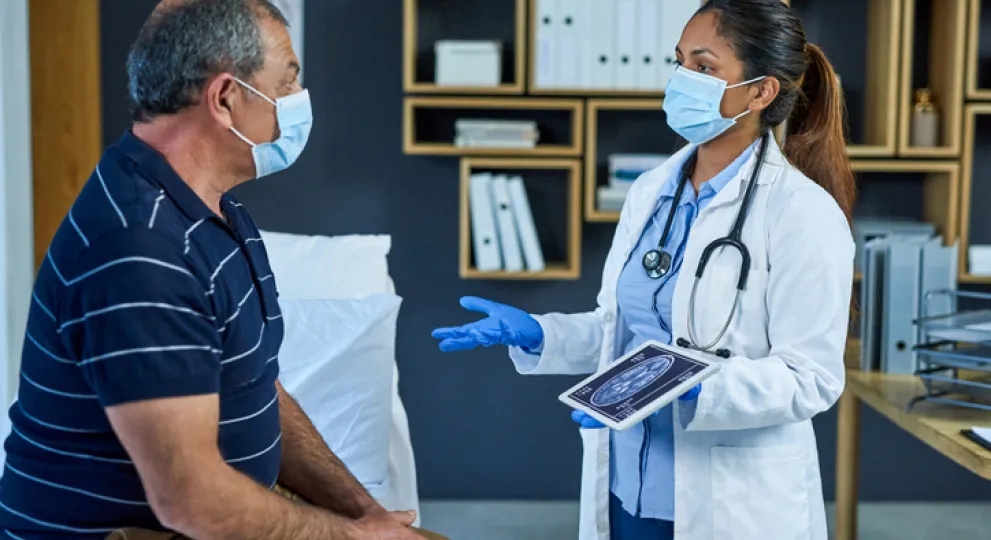Uncommon conditions associated with multiple myeloma
Uncommon conditions associated with multiple myeloma

Sometimes, people with multiple myeloma can also have a condition that is related to their myeloma, such as plasmacytoma [plas-ma-sy-toe-ma] and amyloidosis [ahm-ill-oy-doe-sis]. This article will describe what these conditions are and how they can be treated. Here are some useful definitions:
- Antibody: Protective proteins made by your immune system, which help to remove foreign material like bacteria or viruses. These are also known as immunoglobulins.
- Plasma cell: A type of white blood cell that makes antibodies and helps to protect your body against infections
- Bone marrow: The soft, spongy substance found in the middle of bones where blood cells are made
- Soft tissue: The parts of your body, such as the muscles and skin, that have not been hardened like bones and teeth
- Extramedullary plasmacytoma: A clump of abnormal plasma cells occurring outside the bone marrow
Plasmacytoma
- What is plasmacytoma?
Plasmacytoma is a type of cancer caused by abnormal plasma cells. These abnormal plasma cells grow within the soft tissue or bones, and although the most common sites are the spine or head and neck region, tumors may also emerge elsewhere in the body. Abnormal plasma cells can come together to form a mass. When there is a single (solitary) mass outside of the bone marrow and in soft tissues, this is called a “solitary” extramedullary plasmacytoma. When more than one mass develops, this is usually thought to be part of multiple myeloma.
- What are the signs and symptoms of an extramedullary plasmacytoma?
The exact symptoms caused by a plasmacytoma depend on where it is in your body. For example, if you have a plasmacytoma near your throat then you may experience difficulty swallowing, or if you have a plasmacytoma near your nose then you may feel like you have a blocked nose.
- How is an extramedullary plasmacytoma detected?
Plasmacytomas are usually detected with a scan. A type of imaging scan that is particularly helpful is a “positron emission tomography (PET) – computed tomography (CT)” scan, which combines two different types of scan (a PET scan uses a mildly radioactive drug to show up areas of the body that have more active cells, whereas a CT scan takes a series of pictures throughout the body).
You may also need to undergo a medical procedure so that the plasmacytoma can be looked at in more detail under a microscope – this is called a biopsy. During a biopsy, a small piece of tissue is taken so that your healthcare team can better understand how to treat it.
- How is an extramedullary plasmacytoma treated?
Plasmacytomas can be treated using the same medicine as multiple myeloma. However, radiation therapy with or without surgery may also be used to treat the specific body part affected by the plasmacytoma.
Amyloidosis
- What is amyloidosis?
Amyloidosis in multiple myeloma is another condition caused by abnormal plasma cells, which leads to the build-up of an abnormal protein called amyloid in the body. When amyloid builds up in one place it is called an amyloid deposit. If an amyloid deposit builds up in the organs, it can affect how well the organs work.
There are different types of amyloidosis, which are named after the type of amyloid protein produced. Each type begins with the letter “A”, meaning “amyloidosis”, and is followed by other letters that identify the individual amyloid protein. A type of amyloidosis that can be associated with myeloma is AL amyloidosis, where the “L” stands for
“light chain.”
“Light chains” normally form a part of healthy antibodies, which are made by healthy plasma cells. With AL amyloidosis, abnormal plasma cells make large amounts of light chains, which can lead to an amyloid deposit.
- What are the signs and symptoms of AL amyloidosis?
General symptoms of AL amyloidosis include tiredness, weakness, weight loss, and loss of appetite. Depending on where the amyloid deposits are in your body, you may also have other symptoms. Examples of these include:
- Shoulder pad sign: Swelling of the shoulders
- Gastrointestinal problems: Sickness, diarrhea, weight loss, or feeling full after only eating a small amount
- Kidney problems: Fluid retention
- Skin or nail changes: Bruising or unusual skin or nail changes. This can sometimes be seen as bruises around the eyes and is known as “racoon eyes”
- An enlarged tongue: This is known as macroglossia
- Heart problems: The heart can become stiffer due to the amyloid deposits and may not be able to pump as much blood around the body, leading to shortness of breath. The deposits can also cause arrythmia (an irregular heartbeat) and can lead to breathlessness, dizziness, or fainting
- Neurological problems: Tingling, loss of sensation, or pain in your hands or feet
- How is AL amyloidosis diagnosed?
If it is suspected that you have AL amyloidosis, there are a few tests the doctors may run to confirm it
- Biopsy: A medical procedure where the doctors remove a small amount of tissue to examine it for amyloid deposits
- Blood tests: These can be used to count the number of blood cells that you have. Blood tests can also be used to see how well your kidneys are working by measuring the amount of a protein called creatinine in your blood
- Serum free light chain assay: Doctors can measure the level of light chain in your blood (both normal and abnormal)
- SAP scan: Doctors can measure the amount of serum amyloid P component (SAP), which is a normal protein that binds to amyloid deposits. This scan can show where there is a build-up of amyloid in the body
- How is AL amyloidosis treated?
AL amyloidosis can be treated using similar medicine as those used to treat multiple myeloma. Although this will not cure AL amyloidosis, it may give you a period of time where you aren’t experiencing any symptoms.
Ask your healthcare team about how the diagnosis of either extramedullary plasmacytoma or AL amyloidosis affects your multiple myeloma.













